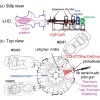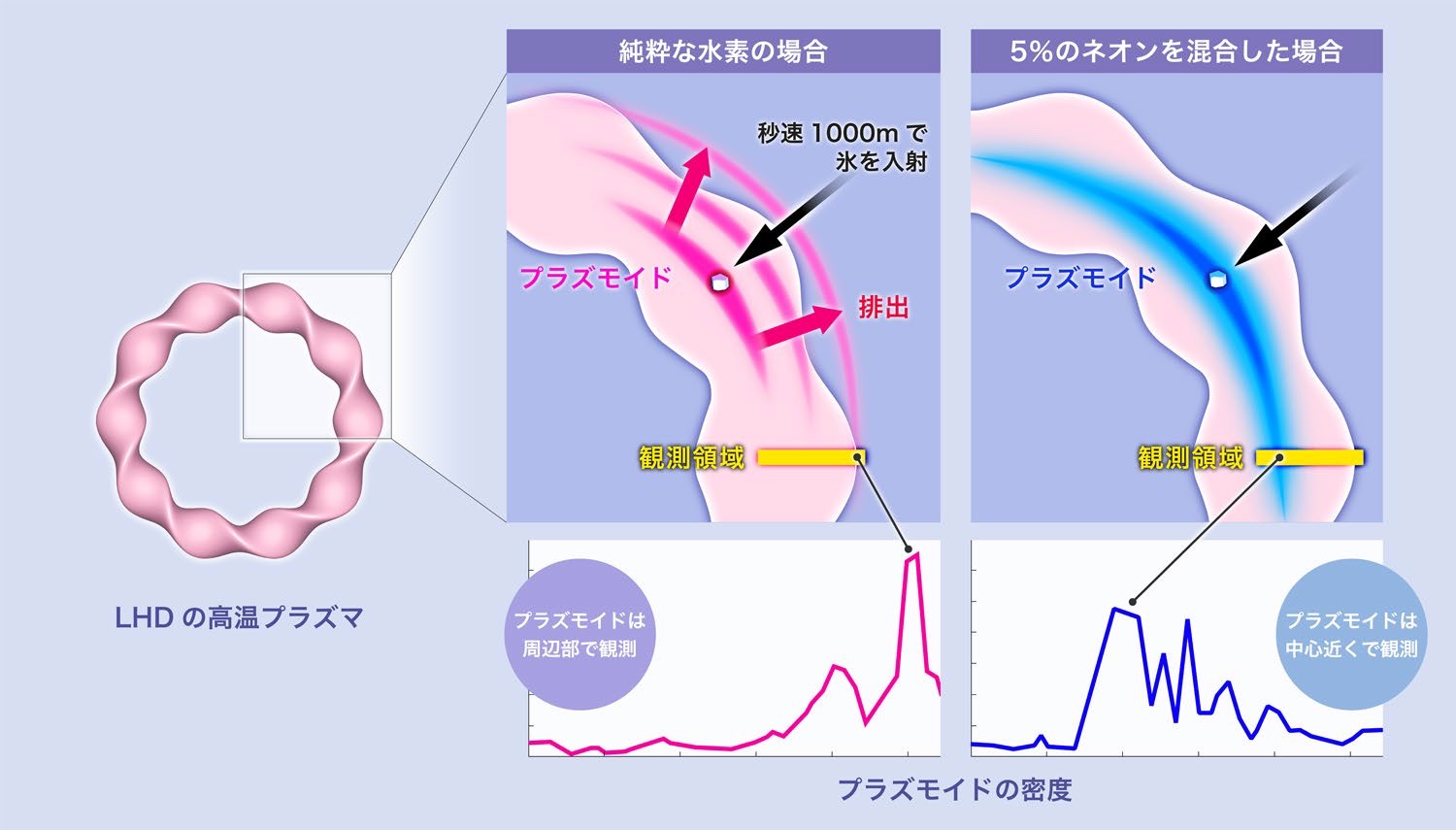

100 million degree plasma: 氷の粒でITERを冷やす!
Refroidir ITER avec des grains de glace !
ITER mit Eiskörnern kühlen!
Cooling ITER with ice grains!
億度等離子體:用冰粒冷卻ITER!
ー日本の量子科学技術研究開発機構が冷却技術を提供ー
量子科学技術研究開発機構:
ー大型ヘリカル装置(LHD)の実験ー
- 磁場で閉じ込めた高温プラズマに、
- ネオンを添加した水素の氷粒を入射すれば、
- 高温プラズマを効果的に深部まで冷却できることを実証した。
核融合実験炉イーター(ITER):
ー高温プラズマの不安定性への対策ー
ITERでは、「強制的に高温プラズマを冷却する技術」が必要とされている。
今回、「ITER運転に不可欠な冷却システムを左右する効果」を解明した。
概要:
ーフランスで建設中の核融合実験炉(ITER)ー
「磁場で閉じ込めた高温のプラズマが、不安定になって放出されること」で、
核融合実験の遂行を妨げる可能性がある。
「ディスラプション」と呼ばれる現象への対策が必要です。
プラズマを強制冷却する技術:
(ディスラプション緩和)日本の量子科学技術研究開発機構が、その技術を開発しました。
「不安定性の兆候を捉えて、プラズマを強制的に冷却すること」ができます。
ネオンを添加:
「水素の氷に5パーセント程度のネオン」を添加しました。
純粋な水素の氷を入射する場合に比べ、
「プラズマの深部まで、冷却出来ること」を明らかにしました。
– 量子科学技術研究開発機構
https://www.qst.go.jp/site/press/20221223.html
Plasma à 100 millions de degrés : Refroidir ITER avec des grains de glace !
ー Les instituts nationaux japonais pour la science et la technologie quantiques et radiologiques fournissent une technologie de refroidissement ー
Instituts nationaux des sciences et technologies quantiques et radiologiques :
-Expérience de grand dispositif hélicoïdal (LHD)-
Dans un plasma à haute température confiné par un champ magnétique,
Si vous injectez des grains de glace à l’hydrogène additionnés de néon,
Nous avons démontré que le plasma à haute température peut être efficacement refroidi en profondeur.
Réacteur de Fusion Expérimental ITER (ITER):
-Mesures contre l’instabilité du plasma à haute température-
Pour ITER, une “technologie de refroidissement forcé du plasma à haute température” est requise.
Cette fois, nous avons précisé les “effets qui influencent le système de refroidissement indispensable au fonctionnement d’ITER”.
Aperçu:
– Réacteur expérimental à fusion (ITER) en construction en France –
“Le plasma à haute température confiné par un champ magnétique devient instable et est libéré.”
Il peut interférer avec l’exécution d’expériences de fusion nucléaire.
Des contre-mesures contre le phénomène appelé « disruption » sont nécessaires.
Technologie de refroidissement forcé du plasma :
(atténuation des perturbations)
Les instituts nationaux japonais des sciences et technologies quantiques et radiologiques ont développé la technologie.
Il est possible “d’attraper des signes d’instabilité et de forcer le refroidissement du plasma”.
Ajouter du néon :
Ajout de “environ 5 % de néon à de la glace d’hydrogène”.
Par rapport à la glace d’hydrogène pur incidente,
Nous avons précisé qu’il est possible de refroidir jusqu’à la partie profonde du plasma.
– Instituts nationaux des sciences et technologies quantiques et radiologiques
100-Millionen-Grad-Plasma: ITER mit Eiskörnern kühlen!
ー Japans National Institutes for Quantum and Radiological Science and Technology bieten Kühltechnologie ー
National Institutes for Quantum and Radiological Science and Technology:
-LHD-Experiment (Large Helical Device)-
In einem von einem Magnetfeld eingeschlossenen Hochtemperaturplasma
Wenn Sie mit Neon versetzte Wasserstoffeiskörner injizieren,
Wir haben gezeigt, dass Hochtemperaturplasmen effektiv bis in die Tiefe gekühlt werden können.
Experimenteller Fusionsreaktor ITER (ITER):
-Maßnahmen gegen Instabilität des Hochtemperaturplasmas-
Für ITER wird „Technologie zur Zwangskühlung von Hochtemperaturplasma“ benötigt.
Diesmal haben wir die „Auswirkungen, die das für den ITER-Betrieb wesentliche Kühlsystem beeinflussen“ geklärt.
Überblick:
– Fusion Experimental Reactor (ITER) im Bau in Frankreich –
“Durch ein Magnetfeld eingeschlossenes Hochtemperaturplasma wird instabil und wird freigesetzt.”
Es kann die Durchführung von Kernfusionsexperimenten stören.
Gegenmaßnahmen gegen das Phänomen „Disruption“ sind notwendig.
Technologie zur Zwangskühlung von Plasma:
(Störungsminderung)
Die Technologie wurde von den japanischen National Institutes for Quantum and Radiological Science and Technology entwickelt.
Es ist möglich, “Anzeichen von Instabilität zu erkennen und das Plasma gewaltsam abzukühlen”.
Neon hinzufügen:
„etwa 5 % Neon zu Wasserstoffeis“ hinzugefügt.
Im Vergleich zu einfallendem reinem Wasserstoffeis
Wir haben klargestellt, dass es möglich ist, bis in den tiefen Teil des Plasmas abzukühlen.
– National Institutes for Quantum and Radiological Science and Technology
Enhanced Material Assimilation in a Toroidal Plasma Using Mixed H2+NePellet Injection and Implications to ITER
Phys. Rev. Lett. 129, 255001 (2022) –
ABSTRACT
The ablation and assimilation of cryogenic pure H 2 and mixed H 2 + Ne pellets,
which are foreseen to be used by the ITER tokamak for mitigating thermal and electromagnetic loads of major disruptions,
are observed by spatially and temporally resolved measurements.
It is experimentally demonstrated that
a small fraction (here ≈ 5 % ) of neon added to hydrogenic pellets enhances the core density assimilation with reduced outward transport for the low magnetic-field side injection.
This is consistent with theoretical expectations that
line radiation increased by doped neon in dense plasmoids suppresses the plasmoid pressure and reduces the → E × → B transport of the ablated material.